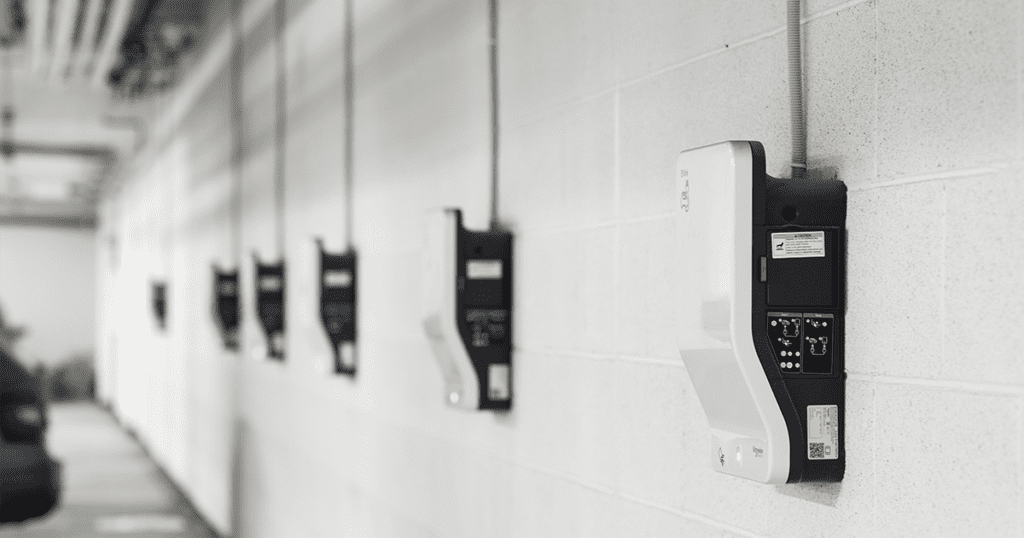We all saw images this summer of climate change in action. Hurricanes and wildfires in the U.S., flooding in China and Germany, and crop-destroying droughts in Kenya composed a grim tableau. We can count on even more extreme and frequent weather events until we get serious about cutting carbon emissions.
One unmistakable remedy at hand is eMobility—the mass-scale electrification of road transportation, a sector that accounts for 24% of global CO2. A full transition to electric vehicles (EVs) depends on tight coordination between multiple diffuse stakeholders.
Many governments are mandating more EVs on roads over the next decade. Increasing the number of EVs is an important first step. But replacing the stock of gas-powered vehicles—cars, vans, buses, and trucks—with EVs is just one strand in a dense web of hardware, software and services where energy management is a must.
To reach the tenfold increase of EVs needed to match these mandates, we need to grapple with some tough questions. What role can buildings play in providing charging infrastructure? How will charging behavior affect energy use in buildings? Can we integrate renewable energy resources with buildings, cars and grids? For each pivotal question, the answer depends on digitalization.
As you might expect, current EV owners do most of their charging conveniently at home. But as EVs take hold of the car market, buildings will take on a larger share of the burden. Despite government plans to construct many more public charging options, we shouldn’t anticipate frequent stops at dedicated charging stations the way we fill up today.
Instead, we will charge at destinations like offices, shops, restaurants, parking garages, schools, hospitals, movie theaters, bowling alleys—you get the idea. When EVs become the dominant mode of transportation, people won’t be stopping to charge; they’ll charge where they stop.

Buildings as the backbone of charging infrastructure
By 2030, McKinsey estimates that buildings around the world will provide 55 million new chargers, consuming 525 TWh per year—roughly equal to Germany’s current annual electricity consumption. Both commercial and residential buildings ought to have chargers to meet demand from employees, customers and residents. That demand is significant. Buildings will need up to 40% more electricity to handle EVs alone.
All this new charging creates challenges for building owners and should motivate many to invest in digital energy management capabilities.
Consider the morning routines in a typical commercial building: The cooling system gets to work preparing for warm temperatures before workers arrive—more or less at the same time—to switch on computers, equipment, coffee machines, and everything else that gobbles electricity. That activity causes a jump in the building’s power use. Add in each worker plugging in a car as they park and what was once a jump is now a leap.
The task of managing this demand is no small feat.
A building generating frequent demand peaks faces much higher energy costs from the utility. Unless you’ve designed the full site’s electrical distribution system to handle new, massive energy loads, the building risks overloading the network and triggering an outage. And if managing the power of one building wasn’t enough, we must equip electric grids to balance multiple buildings in a given area. That way, a consumption spike in the store across the street doesn’t knock out power for the whole block.
The key to mitigating these risks is through intelligent charging, load management, power generation, storage, and synthesis with the rest of the grid. When taken together, this integration of the eMobility ecosystem forms the backbone of EV charging infrastructure. And we can do all of this today with digital technology.
To avoid the demand peaks that cause most of this trouble, each vehicle cannot charge in unison. When we connect charging equipment to a digital control system, real-time intelligence coordinates charging based on variables like current energy costs, demand from other parts of the facility, each vehicle’s charging need, and predictive modeling. Additionally, businesses can assign priority to ensure faster, fuller charges for customers, salespeople, delivery drivers, technicians, or even the employee of the month.
The upward march of EV adoption mirrors the path of renewables. Most of the environmental benefits of EVs rely on cars powering through clean energy sources—sources that become cheaper and more abundant by the day. Buildings play a part in the renewable energy future by producing cheap solar power to mitigate consumption costs and climate impact.
When combined with battery storage and digital tools, renewable energy smooths consumption patterns, keeping costs down and grids in balance. This smart technology can connect to weather forecasts and driving behavior to dole out as much or as little renewable reserves needed to charge car batteries and power the building.
When drivers charge EVs at work or other businesses, they will rely less on home and public charging. This moves demand from one part of town and time of day to another. Building management systems connected with utilities, smart homes and the cars themselves create a fountain of data to inform planning, policy and infrastructure decisions. Data shared with grid operators enables forecasts to ensure power is available to each point in the system to limit outages and downtime.
Digital technology offers the clearest path to optimal infrastructure planning, energy generation, building management, and intelligent charging to make eMobility a reality. We may look back at the summer of 2021 as the good old days if we don’t make bold changes and make them fast. We have the tools we need, it’s high time we put them to use.
To know more about eMobility business:
>>>EcoStruxure for eMobility in Buildings
Check out the upcoming events in our Innovation Summit World Tour and register to get more information on our latest innovations for eMobility, energy management and automation.



